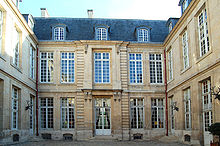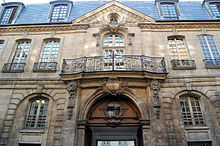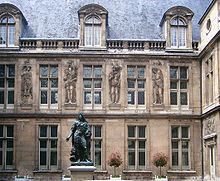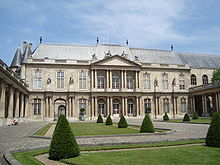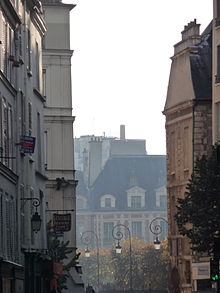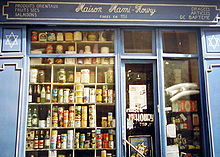- Le Marais
-
-
-
- For other meanings, see Marais (disambiguation).
-
The Hôtel de Sully's Gardens, near the Place des Vosges. rightview of rue des Francs-Bourgeois in direction of Place des Vosges
rightview of rue des Francs-Bourgeois in direction of Place des Vosges
Le Marais ("The Marsh", French pronunciation: [maʁɛ]) is a historic district in Paris, France. Long the aristocratic district of Paris, it hosts many outstanding buildings of historic and architectural importance. It spreads across parts of the 3rd and 4th arrondissements in Paris (on the Rive Droite, or Right Bank, of the Seine).
Contents
History
Paris aristocratic district
In 1240 the Order of the Temple built its fortified church just outside Paris' walls, in the northern part of the Marais. The Temple turned the district into an attractive area, and many religious institutions were built nearby: the des Blancs-Manteaux, de Sainte-Croix-de-la-Bretonnerie and des Carmes-Billettes convents, as well as the church of Sainte-Catherine-du-Val-des-Écoliers.
During the mid-13th century, Charles I of Anjou, King of Naples and Sicily, and brother of King Louis IX of France built his residence near the current n°7 rue de Sévigné.[1] In 1361 the King Charles V built a mansion known as the Hôtel Saint-Pol in which the Royal Court settled during his reign as well as his son's.
From that time to the 17th century and especially after the Royal Square (Place Royale, current place des Vosges) was designed under King Henri IV in 1605, the Marais was the French nobility's favorite place of residence. French nobles built their urban mansions there[2] such as the Hôtel de Sens, the Hôtel de Sully, the Hôtel de Beauvais, the Hôtel Carnavalet, the Hôtel de Guénégaud, and the Hôtel de Soubise.
Jewish community
After the nobility started to move to the Faubourg Saint-Germain, the district became a popular and active commercial area, hosting one of Paris' main Jewish communities. At the end of the 19th century and during the first half of the 20th, the district around the rue des Rosiers, refers to as the"Pletzl", welcomed many Eastern European Jews (Ashkenazi) who reinforced the district clothing specialization. But, during World War II the Jewish community was targeted by the Nazis who were occupying France.
The rue des Rosiers is still a major centre of the Paris Jewish community, which has made a renewal since the 1990s. Public notices announce Jewish events, bookshops specialize in Jewish books, and numerous restaurants and other outlets sell kosher food.
The synagogue on 10 rue Pavée, not far from rue des Rosiers, is a strong religious centre. It was designed in 1913 by Art Nouveau architect Hector Guimard, famous for having designed several Paris Metro stations.
Post-War Rehabilitation
By the 1950s, the district had become a working-class area and most of its architectural masterpieces were in bad state of repair. In 1964, General de Gaulle's Culture Minister Andre Malraux made the Marais the first secteur sauvegardé (Literally secured area). These were meant to protect and conserve places of special cultural significance. The following decades, the government and the Parisian municipality have led an active restoration and Rehabilitation Policy.
The main Hôtels particuliers have been restored and turned into museums: the Hôtel Salé hosts the Picasso Museum, the Hôtel Carnavalet hosts the Paris Historical Museum, the Hôtel Donon hosts the Cognac-Jay Museum etc. The site of Beaubourg, the western part of Marais, was chosen for the Centre Georges Pompidou, France's national Museum of Modern Art and one of the world's most important cultural institutions. The building was completed in 1977 with revolutionary architecture by Renzo Piano and Richard Rogers.
Today's Marais
 Street artist reproducing Vermeer's Girl with a Pearl Earring on the sidewalk(2005).
Street artist reproducing Vermeer's Girl with a Pearl Earring on the sidewalk(2005).
The Marais is now one of Paris' main localities for art galleries. Following its rehabilitation, the Marais has become a fashionable district, home to many trendy restaurants, fashion houses, and hype galleries.
The neighbourhood has experienced a growing gay presence since the 1980s, as evidenced by the existence of many gay cafés, nightclubs, cabarets and shops. These establishments are mainly concentrated in the southwestern portion of the Marais, many on or near the streets Sainte-Croix de la Bretonnerie and Rue des Archives.
The Marais is also known for the strong Chinese community it hosts. The community began during World War I. At that time, France needed workers to replace its at-war soldiers and China decided to send a few thousands of its citizens on the condition that they would not take part of the war. After the 1918's victory, some of them decided to stay in Paris, specifically living around the current rue au Maire. Today, most work in jewelery and leather-related products. The Marais' Chinese community has settled in the north of the district, particularly in the surrounding of Place de la République. Right next to it, on the rue du Temple, is the Chinese Church of Paris.
Other features of the neighbourhood include the Musée Picasso, the house of Nicolas Flamel, the Musée Cognacq-Jay, the Musée Carnavalet and the new and very popular Café Charlot.
Notable residents
- Maximilien de Béthune, duc de Sully
- Urbain de Maillé-Brézé
- Armand de Vignerot du Plessis
- Princes of Rohan Soubise
- Catherine de Vivonne, marquise de Rambouillet
- Marie de Rabutin-Chantal, marquise de Sévigné
- Maximilien Robespierre
- Victor Hugo
- Ellen Mary Howells and Chloe Anna Julius
Places and monuments of note
- Church Saint-Merri
- Church Notre-Dame-des-Blancs-Manteaux
- Hôtel de Sens
- Place des Vosges, including the home of Victor Hugo and café Ma Bourgogne
- Musée Cognacq-Jay
- Musée Picasso
- National Archives, including the Hôtel de Soubise and the Hôtel de Rohan
- Carnavalet Museum
- Hôtel de Sully
- Pletzl, the Jewish quarter
-
A Jewish Bakery in the rue des Rosiers
-
A Jewish Bakery in the rue des Rosiers
References
- ^ This hôtel remained until 1868. The rue du Roi-de-Sicile is named after it.
- ^ Hôtels particuliers in French
External links
- Magical Marais: Place des Vosges, rue du Bourg-Tibourg, etc. Tour the neighbourhood in photographies and descriptions
- Le Marais
- Le Marais: The Indifferent Ghetto Article about Le Marais as the gay neighbourhood of Paris.
- Gay Paris: English speaking gay walks in Paris
- ParisMarais.com: the official guide, partner of the Paris Tourist Office
- Le Marais photos
- Marais district Photographs
Coordinates: 48°51′27.36″N 2°21′41.23″E / 48.8576°N 2.3614528°E
Categories:- Le Marais
- Districts of Paris
- Jewish French history
- Jewish communities
- 3rd arrondissement of Paris
- 4th arrondissement of Paris
- Gay villages
-
Wikimedia Foundation. 2010.


